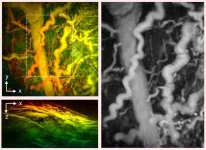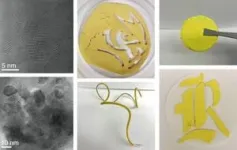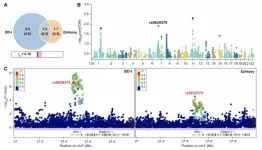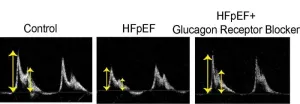(Press-News.org) A new hand-held scanner developed by UCL researchers can generate highly detailed 3D photoacoustic images in just seconds, paving the way for their use in a clinical setting for the first time and offering the potential for earlier disease diagnosis.
In the study, published in Nature Biomedical Engineering, the team show their technology can deliver photoacoustic tomography (PAT) imaging scans to doctors in real time, providing them with accurate and intricate images of blood vessels, helping inform patient care.
Photoacoustic tomography imaging uses laser-generated ultrasound waves to visualise subtle changes (an early marker of disease) in the less-than-millimetre-scale veins and arteries up to 15mm deep in human tissues.
However, up until now, existing PAT technology has been too slow to produce high-enough quality 3D images for use by clinicians.
During a PAT scan patients must be completely motionless, meaning any movement during a slower scan can cause images to blur and therefore not guarantee clinically useful images.
The older PAT scanners took more than five minutes to take an image – by reducing that time to a few seconds or less, image quality is much improved and far more suitable for people who are frail or poorly.
Researchers say the new scanner could help to diagnose cancer, cardiovascular disease and arthritis in three to five years’ time, subject to further testing
Corresponding author, Professor Paul Beard (UCL Medical Physics and Biomedical Engineering and the Wellcome/EPSRC Centre for Interventional and Surgical Sciences), said: “We’ve come a long way with photoacoustic imaging in recent years, but there were still barriers to using it in the clinic.
“The breakthrough in this study is the acceleration in the time it takes to acquire images, which is between 100 and 1,000 times faster than previous scanners.
“This speed avoids motion-induced blurring, providing highly-detailed images of a quality that no other scanner can provide. It also means that rather than taking five minutes or longer, images can be acquired in real time, making it possible to visualise dynamic physiological events.
“These technical advances make the system suitable for clinical use for the first time, allowing us to look at aspects of human biology and disease that we haven’t been able to before.
“Now more research is needed with a larger groups of patients to confirm our findings.”
Professor Beard added that a key potential use for the new scanner was to assess inflammatory arthritis, which requires scanning all 20 finger joints in both hands. With the new scanner, this can be done in a few minutes – older PAT scanners take nearly an hour, which is too long for elderly, frail patients, he said.
Testing the scanner on patients
In the study, the team tested the scanner during pre-clinical tests on 10 patients with type-2 diabetes, rheumatoid arthritis or breast cancer, along with seven healthy volunteers.
In three patients with type-2 diabetes, the scanner was able to produce detailed 3D images of the microvasculature in the feet, highlighting deformities and structural changes in the vessels. The scanner was used to visualise the skin inflammation linked to breast cancer.
Andrew Plumb, Associate Professor of Medical Imaging at UCL and consultant radiologist at UCLH and a senior author of the study, said: “One of the complications often suffered by people with diabetes is low blood flow in the extremities, such as the feet and lower legs, due to damage to the tiny blood vessels in these areas. But until now we haven’t been able to see exactly what is happening to cause this damage or characterise how it develops.
“In one of our patients, we could see smooth, uniform vessels in the left foot and deformed, squiggly vessels in the same region of the right foot, indicative of problems that may lead to tissue damage in future. Photoacoustic imaging could give us much more detailed information to facilitate early diagnosis, as well as better understand disease progression more generally.”
Photoacoustic tomography
Since its early development in 2000, PAT has long been heralded as having the potential to revolutionise our understanding of biological processes and improve the clinical assessment of cancer and other major diseases.
It works using the photoacoustic effect, which occurs when materials absorb light and produce sound waves.
PAT scanners work by firing very short laser bursts at biological tissue. Some of this energy is absorbed, depending on the colour of the target, causing a slight increase in heat and pressure that in turn generates a faint ultrasound wave containing information about the tissue. The whole process takes place in just a fraction of a second.
In earlier research, what physicists and engineers at UCL (led by Professor Beard) discovered was that the ultrasound wave can be detected using light.
In the early 2000s they pioneered a system where a sound wave causes minute changes in thickness of a thin plastic film which can be measured using a highly-tuned laser beam.
The results revealed tissue structures which have never been seen before.
How PAT could assist disease detection
For some conditions, like peripheral vascular disease (PVD), a complication of diabetes, early signs of changes in tiny blood vessels indicative of the disease can’t be seen using conventional imaging techniques such as MRI scans.
But with PAT images they can – offering the potential for treatment before the tissue is damaged and to avoid poor wound healing and amputation, the paper says. PVD affects more than 25 million individuals across the USA and Europe, it adds.
Similarly, with cancer, tumours often have a high density of small blood vessels that are too small to see with other imaging techniques.
Dr Nam Huynh from UCL Medical Physics and Biomedical Engineering, who developed the scanner with colleague Dr Edward Zhang, said: “Photoacoustic imaging could be used to detect the tumour and monitor it relatively easily. It could also be used to help cancer surgeons better distinguish tumour tissue from normal tissue by visualising the blood vessels in the tumour, helping to ensure all of the tumour is removed during surgery and minimising the risk of recurrence. I can envisage lots of ways it will be useful.”
Dr Huynh added that a key advantage of the technology was that it was sensitive to haemoglobin. It is light-absorbing molecules like haemoglobin that produce the ultrasound waves.
Improving and testing the scanner speed
In this study, the UCL researchers sought to overcome the speed problem by reducing the time needed to acquire images. They achieved this by making innovations in the scanner design and the mathematics used to generate the images.
Unlike earlier PAT scanners, which measured the ultrasound waves at more than 10,000 different points over the tissue surface one at a time, the new scanner detects them at multiple points simultaneously, reducing image acquisition time considerably.
The research team also employed similar mathematical principles to those used in digital image compression. This enabled high-quality images to be reconstructed from a few thousand (rather than tens of thousands) of measurements of the ultrasound wave, again speeding up image acquisition. These innovations reduced the imaging time to a few seconds or less than a second, eliminating motion-blur and allowing images of dynamic changes to the tissue to be taken.
The scientists said more research was needed with a larger group of patients to confirm their study’s findings and the extent to which the scanner would be clinically useful in practice.
The first steps to develop photoacoustic tomography for medical imaging were taken in 2000, but the origins of the technique date back to 1880 when former UCL-student Alexander Graham Bell, fresh from inventing the telephone, observed the conversion of sunlight to audible sound.
In 2019, members of the UCL research team founded DeepColor Imaging, a UCL spin-out company who now market a range of scanners based on PAT technology worldwide.
This research was supported by Cancer Research UK, the Engineering & Physical Sciences Research Council, Wellcome, the European Research Council and the National Institute for Health Research University College London Hospitals Biomedical Research Centre.
END
Medical imaging breakthrough could transform cancer and arthritis diagnosis
2024-09-30
ELSE PRESS RELEASES FROM THIS DATE:
Genetic link between bipolar disorder and epilepsy unveiled in groundbreaking study
2024-09-30
Kunming, China - A team of researchers from the Chinese Academy of Sciences has uncovered compelling evidence of a genetic link between bipolar disorder type I (BD-I) and epilepsy, potentially revolutionizing our understanding of these complex neuropsychiatric conditions. The study, published in Genomic Psychiatry on September 30, 2024, reveals shared genetic variants and a causal relationship between the two disorders, opening new avenues for research and treatment.
Led by Dr. Ming Li from the Kunming ...
Social networks help people resolve welfare problems - but only sometimes, new research finds
2024-09-30
Lead researcher Dr Sarah Nason, from Bangor University’s School of History, Law and Social Sciences explained: “Debt, benefits, special educational needs, healthcare issues, these are everyday problems that many of us face, and it’s only natural to turn to people you know and trust for help and advice. However, we found that having to talk to more people or support services was an indicator that the problem was more complex and difficult to resolve.”
The team studied four distinct areas across England and Wales: Bryngwran, a village on Anglesey in North Wales; Deeplish, a district of Rochdale in Greater ...
Honey, I shrunk the city: What should declining Japanese cities do?
2024-09-30
Aging societies and population decline have been on the rise globally, but in Japan, the situation has exasperated tenfold. A staggering 36.21 million people, or 28.9% of the populace, are 65 and over. Further, 74.6% of Japan’s 1,747 cities are categorized as shrinking, with urban policies struggling to keep up with the decline. However, the factors that correlate with population changes in cities of varying sizes have not been clarified.
Dr. Haruka Kato, a junior associate professor at Osaka Metropolitan University, ...
New brain cell cleaner: astrocytes raise possibility of Alzheimer’s disease treatment
2024-09-30
A research team led by Dr. Hoon Ryu from the Korea Institute of Science and Technology (KIST, President Sang-Rok Oh) Brain Disease Research Group, in collaboration with Director Justin C. Lee of the Institute for Basic Science (IBS, President Do-Young Noh) and Professor Junghee Lee from Boston University Chobanian & Avedisian School of Medicine, has uncovered a new mechanism involving astrocytes for treating Alzheimer’s disease (AD) and proposed a novel therapeutic target. In this study, the researchers revealed that autophagy pathway ...
American Academy of Pediatrics announces its first clinical practice guideline for opioid prescriptions
2024-09-30
Media contacts:
Lisa Robinson, lrobinson@aap.org
Alex Hulvalchick, ahulvalchick@aap.org
American Academy of Pediatrics Announces its First Clinical Practice Guideline for Opioid Prescriptions
Pediatricians should prescribe opioids for pain when necessary, with recommended precautions in place to increase safety, according to a clinical practice guideline released during the AAP 2024 National Conference & Exhibition
ORLANDO, Fla.--The American Academy of Pediatrics has published its first clinical ...
Drivers of electric vehicles are more likely to be at fault in road traffic crashes than drivers of petrol and diesel cars
2024-09-30
Drivers of electric vehicles (EVs) are more likely to be involved in at-fault road traffic accidents than drivers of petrol and diesel cars, research by Lero, the Research Ireland Centre for Software, at University of Limerick and Universitat de Barcelona, reveals.
In the analysis of insurance claims and data from onboard sensors, due to be published in the November issue of the journal Accident Analysis & Prevention, the Lero researchers reveal a number of key findings:
Electric and hybrid drivers exhibit different behaviours ...
Duke-NUS study proposes new heart failure treatment targeting abnormal hormone activity
2024-09-30
Duke-NUS scientists and their collaborators have discovered a potential new treatment for heart failure with preserved ejection fraction (HFpEF), a type of heart disease that is notoriously difficult to treat. The team discovered that the diseased heart cells had high levels of glucagon activity, a pancreatic hormone that raises blood sugar (glucose) levels. Armed with this novel insight, the scientists demonstrated that a drug that blocks the hormone’s activity, can significantly improve heart ...
People who experience side effects from cranial radiation therapy may recover full neurocognitive function within months
2024-09-29
WASHINGTON, September 29, 2024 — A substantial number of patients with brain metastases who experience cognitive side effects following radiation therapy may fully regain cognitive function, according to a pooled analysis of three large, phase III clinical trials. Recovery was more likely for people treated with conformal, or highly targeted, radiation techniques, compared to standard whole-brain treatment. The findings will be presented today at the American Society for Radiation Oncology (ASTRO) ...
Radiopharmaceutical therapy offers promise for people with tough-to-treat meningioma brain tumors
2024-09-29
WASHINGTON, September 29, 2024 — A radiopharmaceutical therapy that has successfully extended progression-free survival for patients with neuroendocrine tumors shows early promise for delivering similar benefits to patients with difficult-to-treat meningioma, a type of brain tumor. Findings of the nonrandomized phase II study will be presented today at the American Society for Radiation Oncology (ASTRO) Annual Meeting.
“We’ve found a therapy with a meaningful signal for effectiveness and safety for people with refractory meningioma, a condition with no ...
American Academy of Pediatrics promotes shared reading starting in infancy as a positive parenting practice with lifelong benefits
2024-09-29
ORLANDO, Fla.--The American Academy of Pediatrics encourages parents and caregivers to read aloud with their newborns and young children as an opportunity to foster loving, nurturing relationships during a critical time of brain development, and recommends that pediatricians support families with guidance and books at well-child visits, according to an updated policy statement.
The policy statement, “Literacy Promotion: An Essential Component of Primary Care Pediatric Practice,” marks the first update in AAP recommendations since 2014. Given the extraordinary amount of research in this area, an accompanying ...







